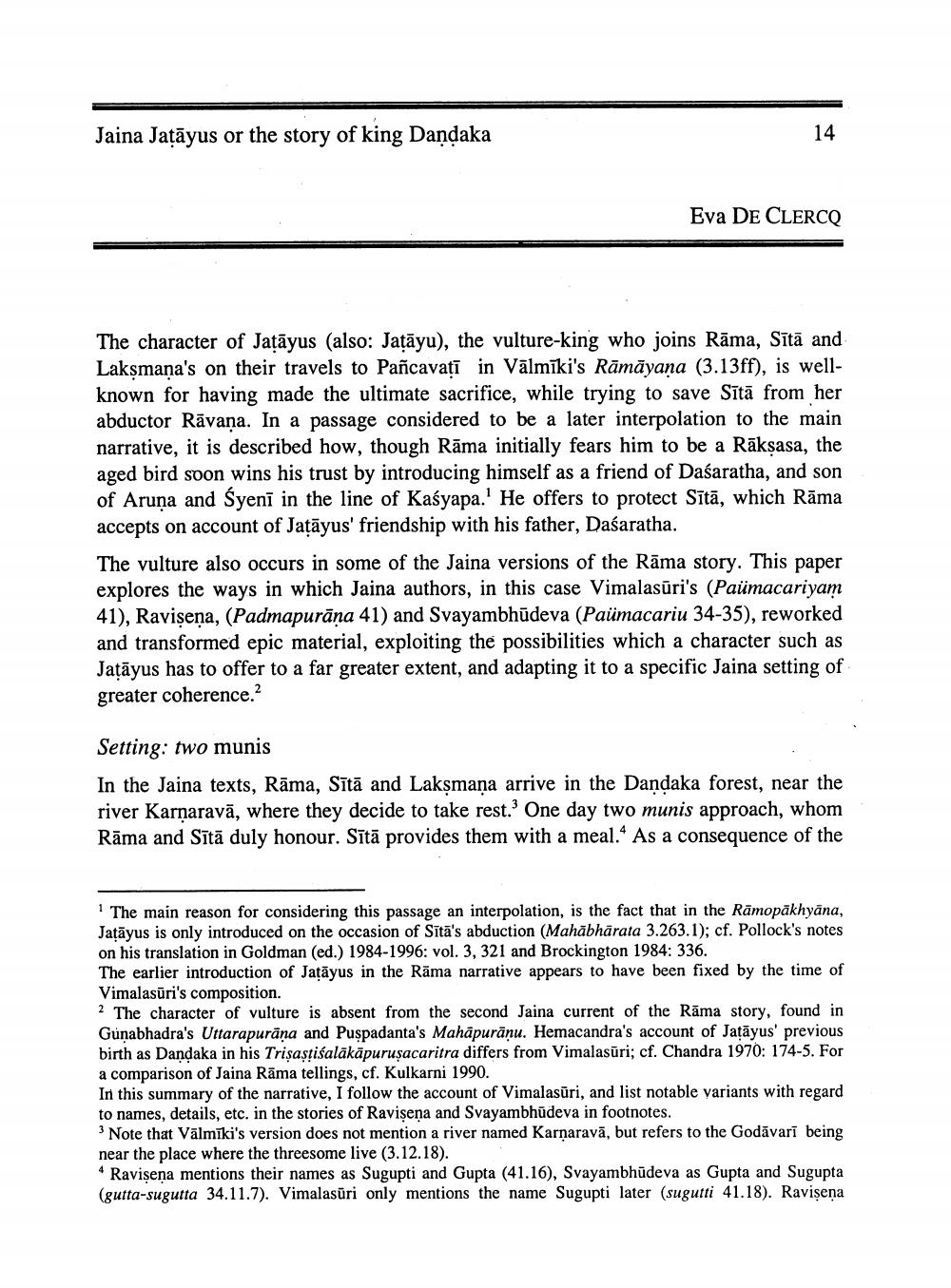________________
Jaina Jatāyus or the story of king Dandaka
Eva DE CLERCQ
The character of Jatāyus (also: Jatāyu), the vulture-king who joins Rāma, Sītā and Laksmana's on their travels to Pañcavati in Vālmīki's Rāmāyaṇa (3.13ff), is wellknown for having made the ultimate sacrifice, while trying to save Sītā from her abductor Rāvaņa. In a passage considered to be a later interpolation to the main narrative, it is described how, though Rāma initially fears him to be a Rāksasa, the aged bird soon wins his trust by introducing himself as a friend of Daśaratha, and son of Aruna and Śyenī in the line of Kaśyapa.' He offers to protect Sītā, which Rāma accepts on account of Jatayus' friendship with his father, Dasaratha. The vulture also occurs in some of the Jaina versions of the Rāma story. This paper explores the ways in which Jaina authors, in this case Vimalasūri's (Paümacariyam 41), Ravisena, (Padmapurāna 41) and Svayambhūdeva (Paümacariu 34-35), reworked and transformed epic material, exploiting the possibilities which a character such as Jațāyus has to offer to a far greater extent, and adapting it to a specific Jaina setting of greater coherence.2
Setting: two munis In the Jaina texts, Rāma, Sītā and Lakşmaņa arrive in the Dandaka forest, near the river Karṇaravā, where they decide to take rest. One day two munis approach, whom Rāma and Sītā duly honour. Sītā provides them with a meal. As a consequence of the
The main reason for considering this passage an interpolation, is the fact that in the Rāmopākhyāna, Jațāyus is only introduced on the occasion of Sītā's abduction (Mahābhārata 3.263.1); cf. Pollock's notes on his translation in Goldman (ed.) 1984-1996: vol. 3, 321 and Brockington 1984: 336. The earlier introduction of Jațāyus in the Rāma narrative appears to have been fixed by the time of Vimalasuri's composition. 2 The character of vulture is absent from the second Jaina current of the Rāma story, found in Gunabhadra's Uttarapuräna and Puspadanta's Mahāpurānu. Hemacandra's account of Jatāyus' previous birth as Dandaka in his Trisastiśaläkāpuruşacaritra differs from Vimalasūri; cf. Chandra 1970: 174-5. For a comparison of Jaina Rāma tellings, cf. Kulkarni 1990. In this summary of the narrative, I follow the account of Vimalasuri, and list notable variants with regard to names, details, etc. in the stories of Ravişena and Svayambhūdeva in footnotes. * Note that Vālmīki's version does not mention a river named Karnaravā, but refers to the Godāvarī being near the place where the threesome live (3.12.18). * Ravişena mentions their names as Sugupti and Gupta (41.16), Svayambhūdeva as Gupta and Sugupta (gutta-sugutta 34.11.7). Vimalasuri only mentions the name Sugupti later (sugutti 41.18). Ravisena




